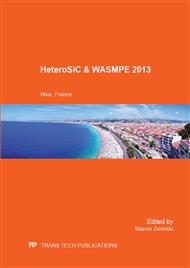[1]
G.Y. Chung, C.C. Tin, J.R. Williams et al., Effect of nitric oxide annealing on the interface trap densities near the band edges in the 4H polytype of silicon carbide, Applied Physics Letters 76 (2000) 1713-1715.
DOI: 10.1063/1.126167
Google Scholar
[2]
J. Rozen A.C. Ahyi, X. Zhu et al., Scaling between channel mobility and interface state density in SiC MOSFETs, IEEE Transactions on Electron Devices 58 (2011) 3808-3811.
DOI: 10.1109/ted.2011.2164800
Google Scholar
[3]
X. Zhu, A.C. Ahyi, M. Li et al., The effect of nitrogen plasma anneals on interface trap density and channel mobility for 4H–SiC MOS devices, Solid-State Electronics 57 (2011) 76-79.
DOI: 10.1016/j.sse.2010.12.002
Google Scholar
[4]
Y. Song, S. Dhar, L.C. Feldman, Modified Deal and Grove model for the thermal oxidation of silicon carbide, Journal of Applied Physics, 95 (2004) 4953-4957.
DOI: 10.1063/1.1690097
Google Scholar
[5]
J.M. Knaup, P. Deak, T. Frauenheim et al., Theoretical study of the mechanism of dry oxidation of 4H-SiC, Physical review B, 71 (2005) 235321-9.
Google Scholar
[6]
A. Gavrikov, A. Knizhnik, A. Safonov et al., First-principles-based investigation of kinetic mechanism of SiC(0001) dry oxidation including defect generation and passivation, Journal of applied physics, 104 (2008) 093508-9.
DOI: 10.1063/1.3006004
Google Scholar
[7]
A. Koh, A. Kestle, C. Wright et al., Comparative surface studies on wet and dry sacrificial thermal oxidation on silicon carbide, Applied Surface Science, 174 (2001) 210-216.
DOI: 10.1016/s0169-4332(01)00150-7
Google Scholar
[8]
B.E. Deal and A.S. Grove, General relationship for the thermal oxidation of silicon, Journal of Applied Physics 36 (1965) 3770-3778.
DOI: 10.1063/1.1713945
Google Scholar
[9]
J.M. Knaup, P. Deak, T. Frauenheim et al., Defects in SiO2 as the possible origin of near interface traps in the SiC/SiO2 system: A systematic theoretical study, Physical review B, 72 (2005) 115323-9.
Google Scholar


